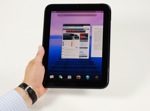 The big story in the world of tablets and e-readers that broke this weekend involves the HP TouchPad. A sort of chain reaction took place starting when a big box retailer shipped hundreds of thousands of unsold units back to HP, which suddenly found itself swimming in unwanted tablets.
The big story in the world of tablets and e-readers that broke this weekend involves the HP TouchPad. A sort of chain reaction took place starting when a big box retailer shipped hundreds of thousands of unsold units back to HP, which suddenly found itself swimming in unwanted tablets.
The sales figures were spectacularly unimpressive: that retailer only managed to sell 25,000 out of the 270,000 tablets it ordered, and deal site Woot only sold 612 of them when it offered them for $120 off earlier this month. The sales figures remind me of the much-maligned JooJoo from Fusion Garage, which reportedly only managed to get 90 people to pre-order its tablet.
As a result, HP decided it will no longer make devices based on WebOS, the operating system it inherited when it bought struggling smartphone-maker Palm last year. (I guess the Palm Pilot really is dead at last.) Licensing it to other device makers is not out of the question, though I wonder after this performance whether any other device makers would really want it.
And as for those tablets it was swimming in, HP has held a fire sale, pricing the 16 GB version at $99 and the 32 GB version at $149. It will also be issuing refunds to those few hardy souls who paid full price for the device. You wouldn’t expect people to be flocking to buy discontinued hardware, but reportedly the tablets have been selling out fast—so fast, in fact, that it crashed HP’s e-commerce servers on Saturday afternoon.
Joe Wilcox at BetaNews points out that the incredible demand for these cheap tablets suggests there is a considerable level of consumer demand for an inexpensive tablet device. We’ve mentioned this before, as when I covered a survey that showed most people wanted Amazon’s tablet to cost less than $250. At less than $100, it’s not surprising they’re flying off the shelves.
Wilcox also notes that, while Apple’s iPad will continue riding high, the sudden glut of cheap competitors on the market could seriously bite into sales of less-successful iPad competitors like Samsung’s, Motorola’s, and RIM’s offerings. This could end up reinforcing Apple’s domination of the tablet market.
Meanwhile, $99-$149 for an inexpensive tablet running a proven OS from a well-known manufacturer certainly beats the pants off all of the cheap Chinese trash offerings that were previously all that price point had to offer. As a friend of mine noted while discussing it, given the e-reading apps available for WebOS you could simply consider it a “cheap color Kindle” and treat the rest of its functionality as a bonus.
It’s going to be interesting to see what this does to the rest of the tablet market—and what would-be iPad competitor will be the next to fall.
































